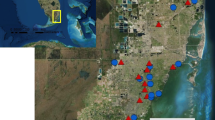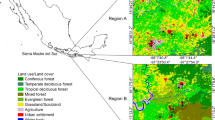Abstract
Landscape structure can influence demographics of spatially structured populations, particularly less vagile organisms such as amphibians. We examined the influence of agricultural landscape structure on community composition and relative abundance of the 4 most common amphibians in the Southern High Plains of central USA. Amphibian populations were monitored using pitfall traps and drift fence at 16 playa wetlands (8 playas/year) in 1999 and 2000. We quantified landscape structure surrounding each playa via estimating 13 spatial metrics that indexed playa isolation and inter-playa landscape complexity. Multivariate ordination and univariate correlations and regressions indicated that landscape structure was associated with community composition and relative abundance for 2 of the 4 amphibians. Spadefoots (Spea multiplicata, S. bombifrons) generally were positively associated with decreasing inter-playa distance and increasing inter-playa landscape complexity. Great Plains toads (Bufo cognatus) and barred tiger salamanders (Ambystoma tigrinum mavortium) usually were negatively associated with spadefoots but not influenced by landscape structure. Composition and relative abundance patterns were related to amphibian body size, which can influence species vagility and perception to landscape permeability. Spatial separation of these species in the multivariate ordination also may have been a consequence of differential competitive ability among species. These results suggest agricultural landscape structure may influence abundance and composition of spatially structured amphibian populations. This also is the first applied documentation that inter-patch landscape complexity can affect intra-patch community composition of amphibians as predicted by metapopulation theory. In the Southern High Plains, landscape complexity is positively associated with agricultural cultivation. Agricultural cultivation increases sedimentation, decreases hydroperiod, alters amphibian community dynamics, and negatively impacts postmetamorphic body size of amphibians in playa wetlands. Thus, conservation efforts should focus on preserving or restoring native landscape structure, hydroperiod, and connectivity among playas to maintain native amphibian populations and historic inter-playa movement.
Similar content being viewed by others
References
Anderson A.M., Haukos D.A. and Anderson J.T. 1999. Diet composition of three anurans from the playa wetlands of northwest Texas. Copeia 1999: 515–520.
Bascompte J. and Solé R. V. 1996. Habitat fragmentation and extinction thresholds in spatially explicit models. Journal of Animal Ecology 65: 465–473.
Burel F. 1989. Landscape structure effects on carabid beetles spatial patterns in western France. Landscape Ecology 2: 215–226.
Crist T.O., Guertin D.S., Wiens J.A. and Milne B.T. 1992. Animal movement in heterogeneous landscapes: an experiment with Eleodes beetles in shortgrass prairie. Functional Ecology 6: 536–544.
Dayton G.H. and Fitzgerald L.A. 2001. Competition, predation, and the distributions of four desert anurans. Oecologia 129: 430–435.
Driscoll D. A. 1997. Mobility and metapopulation structure of Geocrinia alba and Geocrinia vitellina, two endangered frog species from southwestern Australia. Australian Journal of Ecology 22: 185–195.
Dodd Jr., C. K. and Scott D. E. 1994. Drift fences encircling breeding sites.. In: Heyer W.R., Donnelly M.A., McDiarmid R.W., Hayek L.-A.C. and Foster M.S. (eds), Measuring and monitoring biological diversity: standard methods for amphibians. Smithsonian Institution, Washington, D.C., USA, pp. 125–130.
Fahrig L. and Merriam G. 1985. Habitat patch connectivity and population survival. Ecology 66: 1762–1768.
Fahrig L. and Merriam G. 1994. Conservation of fragmented populations. Conservation Biology 8: 50–59.
Fahrig L. and Paloheimo J. 1988. Determinants of local population size in patchy habitats. Theoretical Population Biology 34: 194–212.
Gehlbach F.R. 1967. Evolution of the tiger salamander (Ambystoma tigrinum) on the Grand Canyon rims, Arizona. Yearbook of the American Philosophical Society 1967: 266–269.
Gehlbach F.R., Kimmel J.R. and Weems W.A. 1969. Aggregations and body water relations in tiger salamanders (Ambystoma tigrinum) from the Grand Canyon rims, Arizona. Physiological Zoology 42: 173–182.
Gray M.J. 2002. Effect of anthropogenic disturbance and landscape structure on body size, demographics, and chaotic dynamics of Southern High Plains amphibians. Ph.D. Thesis, Texas Tech University, Lubbock, USA, 180 pp.
Gray M.J., Smith L.M. and Brenes R. 2004. Effects of agricultural cultivation on demographics of Southern High Plains amphibians. Conservation Biology 18: (in press).
Guerry A.D. and Hunter Jr. M.L. 2002. Amphibian distributions in a landscape of forests and agriculture: an examination of landscape composition and configuration. Conservation Biology 16: 745–754.
Guthery F.S. and Bryant F.C. 1982. Status of playas in the Southern Great Plains. Wildlife Society Bulletin 10: 309–317.
Hess G. 1996. Linking extinction to connectivity and habitat destruction in metapopulation models. American Naturalist 148: 226–236.
Heyer W.R., Donnelly M.A., McDiarmid R.W., Hayek L.- A.C. and Foster M.S. (eds) 1994. Measuring and monitoring biological diversity: standard methods for amphibians. Smithsonian Institution, Washington, D.C., USA.
Houlahan J.E., Findlay C.S., Schmidt B.R., Meyers A.H. and Kuzmin S.L. 2000. Quantitative evidence for global amphibian population declines. Nature 404: 752–755.
Knutson M.G., Sauer J.R., Olsen D.A., Mossman M.J., Hemesath L.M. and Lannoo M.J. 1999. Effects of landscape composition and wetland fragmentation on frog and toad abundance and species richness in Iowa and Wisconsin, U.S.A. Conservation Biology 13: 1437–1446.
Kolozsvary M.B. and Swihart R.K. 1999. Habitat fragmentation and the distribution of amphibians: patch and landscape correlates in farmland. Canadian Journal of Zoology 77: 1288–1299.
Lefkovitch L. P. and Fahrig L. 1985. Spatial characteristics of habitat patches and population survival. Ecological Modelling 30: 297–308.
Luo H.R., Smith L.M., Allen B.L. and Haukos D.A. 1997. Effects of sedimentation on playa wetland volume. Ecological Applications 7: 247–252.
Luo H.R., Smith L.M., Haukos D.A. and Allen B.L. 1999. Sources of recently deposited sediments in playa wetlands. Wetlands 19: 176–181.
Marsh D.M. and Pearman P.B. 1997. Effects of habitat fragmentation on the abundance of two species of Leptodactylid frogs in an Andean montane forest. Conservation Biology 11: 1323–1328.
Marsh D.M. and Trenham P.C. 2001. Metapopulation dynamics and amphibian conservation. Conservation Biology 15: 40–49.
McGarigal K. and Marks B.J. 1995. FRAGSTATS: spatial pattern analysis program for quantifying landscape structure. U.S. Forest Service General Technical Report PNW-GTR-351.
McIntyre N. E. 2000. Community structure of Eleodes beetles (Coleoptera: Tenebrionidae) in the shortgrass steppe: scale-dependent uses of heterogeneity. Western North American Naturalist 60: 1–15.
Miaud C., Sanuy D. and Avrillier J.-N. 2000. Terrestrial movements of the natterjack toad Bufo calamita (Amphibia, Anura) in a semi-arid, agricultural landscape. Amphibia-Reptilia 21: 357–369.
Milton J.S. and Arnold J.C. 1995. Introduction to probability and statistics. Third edition, McGraw-Hill, New York, New York, USA.
Morin P.J. 1983. Predation, competition, and the composition of larval anuran guilds. Ecological Monographs 53: 119–138.
Peters R.H. 1983. The ecological implications of body size. Cambridge University, Cambridge, UK.
Pope S.E., Fahrig L. and Merriam G. 2000. Landscape complementation and metapopulation effects on leopard frog populations. Ecology 80: 2326–2337.
Ritchie M.E. 1997. Populations in a landscape context: sources, sinks, and metapopulations.. In: Bissonette J.A. (ed.), Wildlife and landscape ecology: effects of pattern and scale. Springer-Verläg, New York, New York, USA, pp. 160–184.
Rosenzweig M.L. 1995. Species diversity in space and time. Cambridge University, New York, New York, USA.
Rothermel B.B. and Semlitsch R.D. 2002. An experimental investigation of landscape resistance of forest versus old-field habitats to emigrating juvenile amphibians. Conservation Biology 16: 1324–1332.
Scribner K.T., Arntzen J.W., Cruddace N., Oldham R.S. and Burke T. 2001. Environmental correlates of toad abundance and population genetic diversity. Biological Conservation 98: 201–210.
Sinsch U. 1990. Migration and orientation in anuran amphibians. Ethology Ecology and Evolution 2: 65–79.
Sinsch U. 1997. Postmetamorphic dispersal and recruitment of first breeders in a Bufo calamita metapopulation. Oecologia 112: 42–47.
Sjögren P. 1991. Extinction and isolation gradients in metapopulations: the case of the pool frog (Rana lessonae). Biological Journal of the Linnean Society 42: 135–147.
Smith L.M. 2003. Playas of the Great Plains. University of Texas, Austin, Texas, USA.
Smith L.M., Gray M.J. and Quarles A. 2003. Diets of newly metamorphosed amphibians in West Texas playas. Southwestern Naturalist 50: (in press).
Smith L.M. and Haukos D.A. 2002. Floral diversity in relation to playa wetland area and watershed disturbance. Conservation Biology 16: 964–974.
Stacey P.B., Johnson V.A. and Taper M.L. 1997. Migration within metapopulations: the impact upon local population dynamics. In: Hanski I.A. and Gilpin M.E. (eds), Metapopulation biology: ecology, genetics, and evolution. Academic, San Diego, California, USA, pp. 267–291.
Stamps J.A., Buechner M. and Krishnan V.V. 1987. The effects of edge permeability and habitat geometry on emigration from patches of habitat. American Naturalist 129: 533–552.
Szacki J. 1999. Spatially structured populations: how much do they match the classic metapopulation concept? Landscape Ecology 14: 369–379.
Taylor P.D., Fahrig L., Henein K. and Merriam G. 1993. Connectivity is a vital element of landscape structure. Oikos 68: 571–573.
ter Braak C.J.F. 1986. Canonical correspondence analysis: a new eigenvector technique for multivariate direct gradient analysis. Ecology 67: 1167–1179.
ter Braak C.J.F. 1994. Canonical community ordination. Part I: basic theory and linear methods. Ecoscience 1: 127–140.
ter Braak C.J.F. 1995. Ordination. In: Jongman R.H.G., ter Braak C.J.F. and Van Tongeren O.F.R. (eds), Data analysis in community and landscape ecology. Cambridge University, Cambridge, UK, pp. 91–173.
ter Braak C.J.F. and Šmilauer P. 1998. CANOCO reference manual and user’s guide to Canoco for windows: software for canonical community ordination (version 4). Microcomputer Power, Ithaca, New York, New York, USA.
Wiens J.A. 1997. Metapopulation dynamics and landscape ecology. In: Hanski I. A. and Gilpin M.E. (eds), Metapopulation biology: ecology, genetics, and evolution. Academic, New York, New York, USA, pp. 43–62.
Wiens J.A., Schooley R.L. and Weeks R.D. Jr. 1997. Patchy landscapes and animal movements: do beetles percolate? Oikos 78: 257–264.
Wilbur H.M. 1987. Regulation of structure in complex systems: experimental temporary pond communities. Ecology 68: 1437–1452.
With K.A. 1994. Ontogenetic shifts in how grasshoppers interact with landscape structure: an analysis of movement patterns. Functional Ecology 8: 477–485.
With K.A. and Crist T.O. 1995. Critical thresholds in species’ responses to landscape structure. Ecology 76: 2446–2459.
Author information
Authors and Affiliations
Corresponding author
Rights and permissions
About this article
Cite this article
Gray, M.J., Smith, L.M. & Leyva, R.I. Influence of agricultural landscape structure on a Southern High Plains, USA, amphibian assemblage. Landscape Ecol 19, 719–729 (2004). https://doi.org/10.1007/s10980-005-1129-3
Received:
Accepted:
Issue Date:
DOI: https://doi.org/10.1007/s10980-005-1129-3




